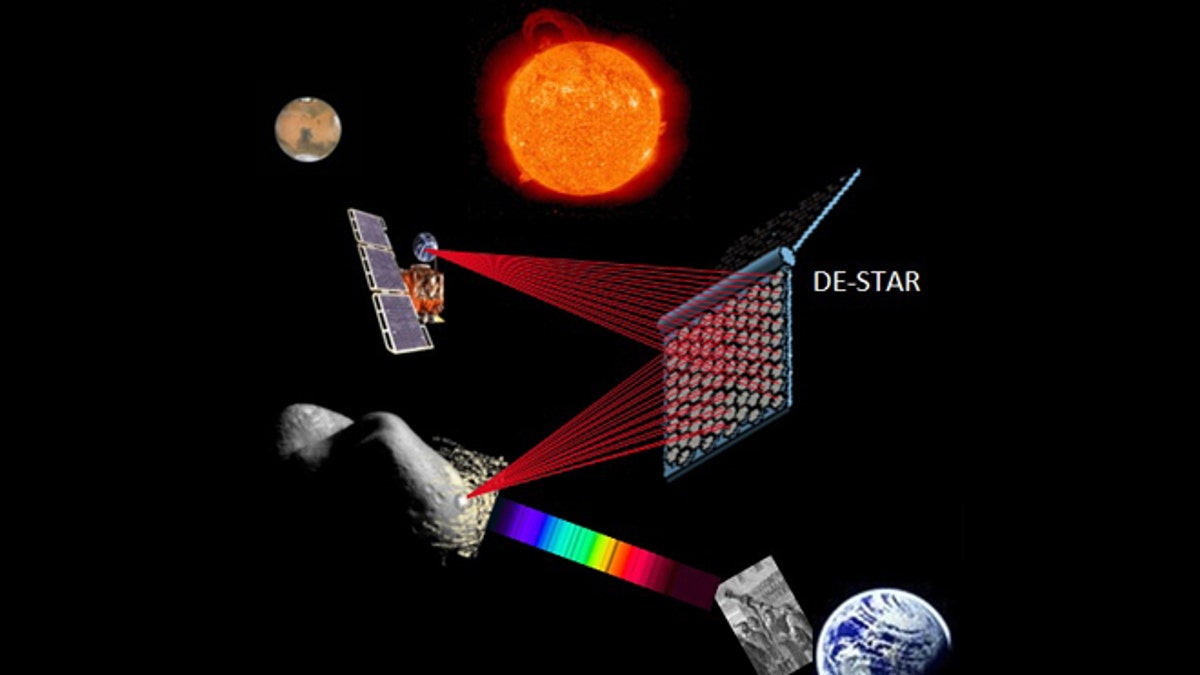
Concept drawing of the DE-STAR system engaging both an asteroid for evaporation or composition analysis, and simultaneously propelling an interplanetary spacecraft. (Philip M. Lubin)
Could a “Deathstar” someday defend Earth against incoming threats from space?
Last Friday, asteroid 2012 DA14 -- half a football field long and weighing about 190,000 tons -- missed planet Earth in a fly-by. Far smaller and therefore harder to detect was the 50 foot long asteroid that injured more than 1,000 Russians when it stuck a few hours earlier.
What can we do about these dangerous asteroid threats? Options on the table include detonating a nuclear weapon near the surface or below a threatening object, “Armageddon” style, or slamming a spacecraft into it to knock it off course.
'This system is not some far-out idea from Star Trek. All the components of this system pretty much exist today.'
Two California scientists have a better idea for how to save the world: a Deathstar, straight out of "Star Wars."
Philip Lubin of the University of California Santa Barbara and Gary Hughes of California Polytechnic State University believe a directed-energy orbital defense system could eliminate a threat on the scale of 2012 DA14 in an hour.
- Fire in the sky: Nearly 1,100 injured as meteor falls in Russia
- ‘Stratospheric’ prices for Russian meteor fragments
- Asteroid 2012 DA14: 5 Surprising Facts About Friday’s Earth Flyby
- About 1,100 injured as meteorite hits Russia with force of atomic bomb
- Russian meteor blast recalls massive 1908 ‘Tunguska event’
- Russian meteorite: Why didn’t scientists see it coming?
Designed to destroy or deflect an asteroid, DE-STAR, or Directed Energy Solar Targeting of Asteroids, harnesses power from the sun and converts it into a massive phased laser beam array.
The laser beams can destroy or evaporate asteroids that pose a threat to Earth. It can also be used to deflect them away from the Earth or into the sun.
Deflection may be preferred to save the asteroid for lucrative, rare-element mining. Deep Space Industries announced earlier this year it will be racing against Planetary Resources to send mining missions to asteroids.
The scientists say it is based on current technology and enabled by advances in efficient conversion of electrical power to light.
The DE-STAR system is apparently scalable, ranging from a desktop device to one as large as six miles long – the larger the system the greater its power.
According to the researchers, it even has the potential to destroy asteroids 10 times larger, the size of five football fields. It would take a year to vaporize one that giant but it would start evaporating it from as far away as the Sun.
For example, the DE-STAR 4 about 100 times the size of the International Space System could deliver 1.4 megatons of energy per day to its target.
The team says the same DE-STAR could also be used for deep space exploration.
The system would accelerate interplanetary travel speed, power deep space travel advanced ion drive systems and could “simultaneously evaporate an asteroid, determine the composition of another, and propel a spacecraft."
They believe their larger DE-STAR 6 could be a massive orbiting power source and could propel a 10-ton spacecraft at near the speed of light making interstellar possible.
Ballet dancer turned defense specialist Allison Barrie has traveled around the world covering the military, terrorism, weapons advancements and life on the front line. You can reach her at wargames@foxnews.com or follow her on Twitter @Allison_Barrie.
